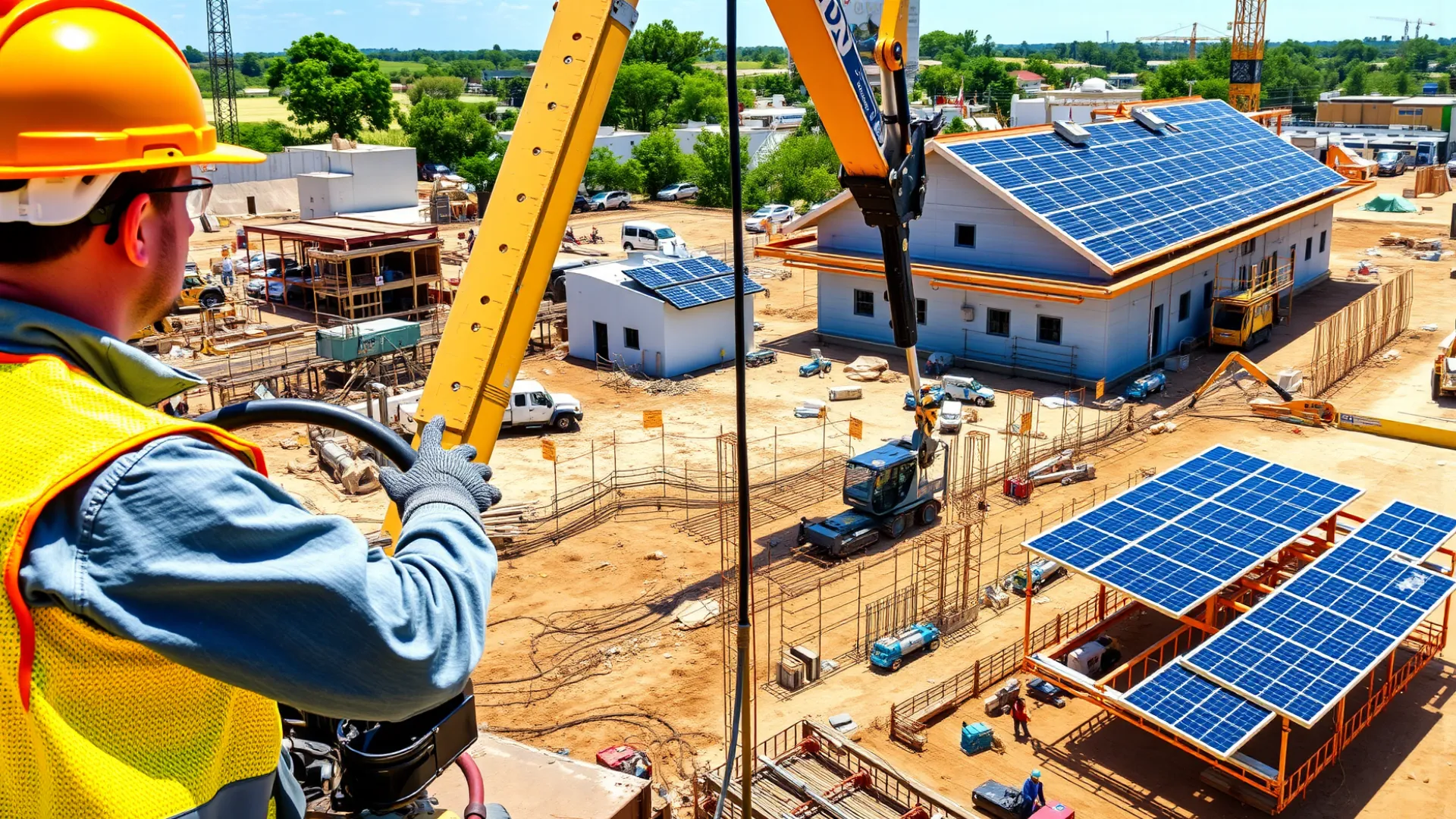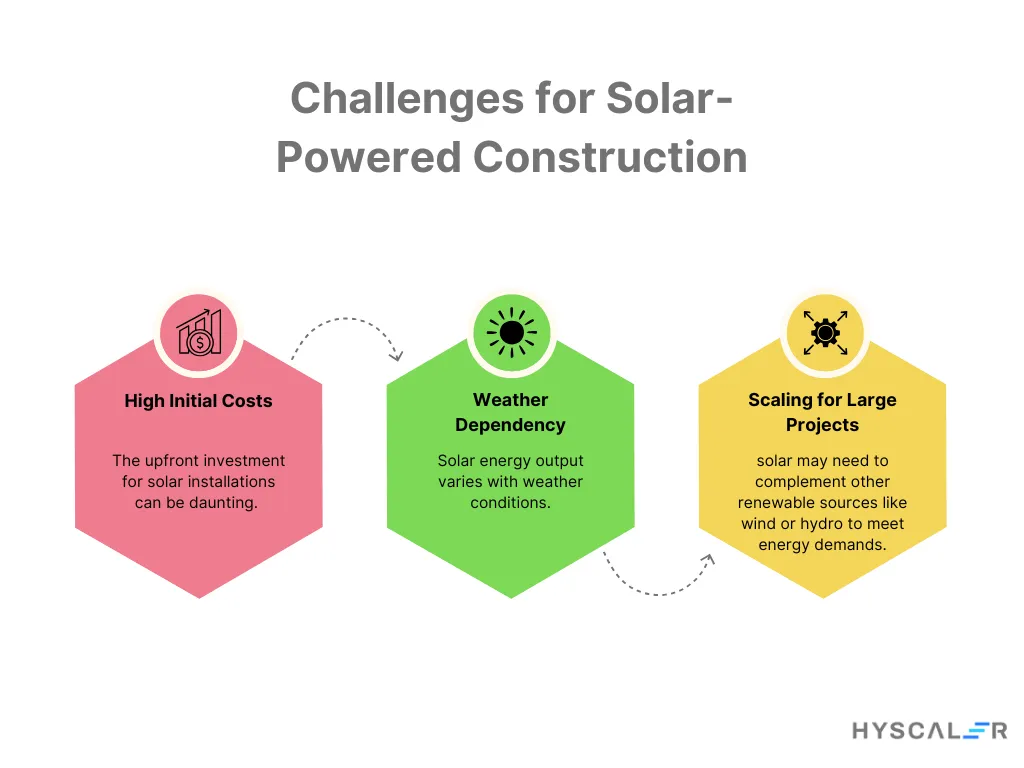Table of Contents
Solar-powered construction sites are heralding a transformative wave in the construction industry. With the tectonic shifts in the world’s direction toward sustainability, construction is, itself, the next key contributor to global carbon emissions, thus turning towards solar energy is one of the most viable alternatives for powering operations.
According to a report by the World Economic Forum, solar power in construction will be a major turning point in the advancement of environmentally sustainable development, with the sector amounting to approximately 39% of total global carbon emissions.
An environmental necessity, but also a business opportunity for solar energy, as it becomes more viable, cheaper, and incentivized by governments worldwide.
The Rise of Solar-Powered Construction
The idea for solar-powered construction sites is simple yet revolutionary. With portable solar panels and energy storage, construction companies can produce renewable power on-site, thereby eliminating or greatly reducing their reliance on diesel generators and grid electricity.
According to the International Energy Agency (IEA), Global CO2 emissions from energy combustion and industrial processes rebounded in 2021 to reach their highest-ever annual level. A 6% increase from 2020 pushed emissions to 36.3 gigatonnes (Gt), an estimate based on the IEA’s detailed region-by-region and fuel-by-fuel analysis, drawing on the latest official national data and publicly available energy, economic, and weather data.
In the US, solar-powered construction is supported by federal tax credits covering installation costs worth up to 30%. The European Union, on the other hand, has vowed to reduce building sector emissions by 60% by 2030, thus pushing for solar integration in all industries.
The long-run benefits of such cleaners become even clearer now as more builders move toward adopting solar-powered construction solutions not just to help drive their footprint towards carbon neutrality but also with better savings that they can achieve on costs. They can substantially reduce costs by avoiding the purchase of fuel for generators and lowering conventional equipment maintenance.
With the advancement and decline in prices for solar developments, the return on investment will keep increasing for solar-powered construction job sites, making them a better option in financial terms for the industry. This shift, therefore, combines the basics of sustainability with a chance to score corporate brownie points for innovations and environmental cooperation.

A Day in the Life of the Solar-Powered Sites
On an active construction site, imagine entering the towering cranes and the heavy-duty machinery humming in quiet efficiency, no diesel fumes here, just solar silent power. In the meantime, the workers gather in the solar-powered site office. Computers, air conditioning, and lighting work without a hitch.
At night, all the lights are kept on by tower lights powered by solar energy, which use a fraction of the energy compared to conventional lighting. Even electric construction vehicles receive their supply on-site from mobile solar charging stations.
Not in some far-off time, but today. Skanska and Balfour Beatty are already testing solar technologies on projects, setting benchmarks for the rest of the industry.
How Solar-Powered Construction Works
Solar-powered construction sites work on a combination of three components; solar panels, battery storage, and solar generators, each performing its part in providing clean renewable energy to construction operations.
Solar Panels
Solar panels are the core of any solar electricity generating system as they are used to convert sunlight into electricity. Portable ones are best for construction since they can be rearranged throughout the day to capture optimum sunlight. Following the sun’s path, solar panels can be adjusted or equipped with solar tracking systems to help capture as much sunlight as possible. Their overall efficiency in reducing reliance upon grid power or fuel-based generators means cost savings.
Battery Storage
This energy storage system is another important component that takes excess energy and stores it in batteries between several and many hours for use either later, but especially at night or during cloudy weather. Depending on how much power the site turns to use, systems such as Tesla Powerwall provide the configuration to store and discharge the energy.
The price for these energy storage systems has fallen quite a bit over the years, dropping roughly 85% since 2010, which has made them an option feasible for construction sites. This now affords the job sites independence to operate without outside power sources, meaning cost and carbon savings.
Solar Generators
Solar generators are small systems with the necessary equipment to supply battery-stored power from solar energy generated during the day to power tools and equipment lighting. They completely replace traditional diesel generators. Closer and cleaner than the power stations, some are geriatric, and additional maintenance is no longer required.
It also supports powering the tools and types of machinery necessary on-site, thereby allowing continuous operations, without harming natural habitats and with full operational ease to achieve diesel alternatives.
Economic and Operational Benefits
Government Incentives:
Several countries provide financial credits to their citizens to promote the installation of solar. The solar tax credit, also called the ITC, enables companies in the United States to deduct 30% of installation costs, hence lowering the initial capital that needs to be outlaid.
Operational Savings:
A monthly running cost of approximately $4,000 is incurred by diesel generators in mid-sized sites. On the other hand, solar has no running costs in terms of fuel. Solar systems earn back their revenues with an estimated further gain over 25 and 30 years.
Cost of solar declining:
In particular, solar panel costs have fallen by a whopping 70% since 2010, rendering them even more suitable for construction in all forms.
Battery Storage:
Due to better advancement, modern battery technology has catalyzed a growing comfort level of reliability in solar. Tesla’s Powerwall, for example, readily stores surplus energy for a night or a cloudy day sun-harvesting. Battery costs have plunged by 85% due to price drops since 2010; more affordable options now abound.
Real-World Success Stories
Of the solar lighting towers by Skanska: Skanska, one of the world’s largest construction firms, initiated the installation of solar-powered lighting towers on a UK highway project. The action resulted in reducing C02 emissions by 50%, which saved the company $300,000 over a period of two years.
Brisbane Airport Project: Within the Brisbane Airport expansion project, solar panels provided power to construction machinery and site administration, reducing energy expenses and emissions by 20% across the project’s scope.
Kenyan Health Center Construction: A solar-powered construction site in a remote Kenyan village built a health center entirely off-grid, showcasing the potential of renewable energy in underserved areas.
The Path Forward
Solar-powered construction sites are more than just an environmental solution but a glimpse toward the industry’s future. Governments, companies, and consumers pushing for greener solutions will build up a consensus around solar as the normative way of doing things, rather than an exception here and there.
According to a report by McKinsey & Company, companies that adopt sustainable practices, such as solar energy, saw an increase in investor interest by an average of nearly 20% and a boost in customer satisfaction by more than 15%.
By rethinking the operations of solar-powered construction sites, the industry can offer a way forward in the fight against climate change while also commercializing and enhancing reputation development. Solar-power construction sites are proof of how innovation and sustainability can exist at the same time.

Closing Thoughts
Solar-powered construction is a path to tread upon. Be it an edifice or a home, embedding solar technology is a step into a cleaner and sustainable lifestyle. Switching to renewable sources means savings and a smaller environmental footprint while mitigating the forces of climate change.
While we are moving away from the outdated, polluting practices, a new era is upon us—a scenario where energy efficiency, sustainability, and innovation exist on the forefront of construction. Solar power stands for the new order, erecting a bright, practical solution to the contemporary issues that plague the industry.
Let solar-powered construction pave the way as we build a better tomorrow, one construction site at a time. The future for the industry is bright and solar powered.